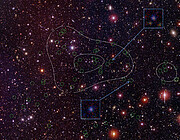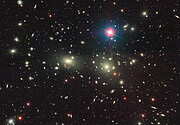A Young Mammoth Cluster of Galaxies Sighted in the Early Universe
25 May 2016
Astronomers have uncovered evidence for a vast collection of young galaxies 12 billion light years away. The newly discovered “proto-cluster” of galaxies, observed when the universe was only 1.7 billion years old (12% of its present age), is one of the most massive structures known at that distance. The discovery, made using telescopes at Kitt Peak National Observatory in Arizona and the W. M. Keck Observatory on Mauna Kea, has been reported in the Astrophysical Journal.
“The protocluster will very likely grow into a massive cluster of galaxies like the Coma cluster, which weighs more than a quadrillion suns,” said Purdue University astrophysicist Dr. Kyoung-Soo Lee, who initially spotted the protocluster and is one of the authors in this study. Clusters this massive are extremely rare: only a handful of candidates are known at such early times. The new system is the first to be confirmed using extensive spectroscopy to establish cluster membership.
The team, led by Dr. Lee (Purdue University) and Dr. Arjun Dey of the National Optical Astronomy Observatory, used the Mayall telescope on Kitt Peak to obtain very deep images of a small patch of sky, about the size of two full moons, in the constellation of Bootes. The team then used the Keck II Telescope on Mauna Kea to measure distances to faint galaxies in this patch, which revealed the large grouping. “Many of the faint galaxies in this patch lie at the same distance,” say Dr. Dey. “They are clumped together due to gravity and the evidence suggests that the cluster is in the process of forming.”
Matter in the universe organizes itself into large structures through the action of gravity. Most stars are in galaxies, which in turn collect in groups and clusters. Galaxy clusters are commonly observed in the present-day universe and contain some of the oldest and most massive galaxies known. The formation and early history of these clusters is not well understood. The discovery of young proto-clusters allows scientists to directly witness and study their formation. The prevalence of massive clusters in the young universe can help constrain the size and expansion history of the universe.
The team is now searching larger areas of sky to uncover more examples of such young and massive protoclusters. “The discovery and confirmation of one distant and very massive protocluster is very exciting,” said Dr. Naveen Reddy, an astrophysicist at the University of California at Riverside and a coauthor of the study, “but it is important to find a large sample of these so we can understand the possibly varied formation history of the population as a whole.”
The other members of the team are Dr. Michael Cooper (University of California, Irvine), Dr. Hanae Inami (Observatoire de Lyon), Dr. Sungryong Hong (University of Texas, Austin), Dr. Anthony Gonzalez (University of Florida), and Dr. Buell Jannuzi (University of Arizona).
More information
“Spectroscopic Confirmation of a Protocluster at z=3.786,” Arjun Dey, Kyoung-Soo Lee, Naveen Reddy et al., 2016 May 20, Astrophysical Journal
preprint: http://arxiv.org/abs/1604.08627
Kitt Peak National Observatory and the National Optical Astronomy Observatory are operated by the Association of Universities for Research in Astronomy under a Cooperative Agreement with the National Science Foundation. The W. M. Keck Observatory is a scientific partnership between the National Aeronautics and Space Administration, the California Institute of Technology and the University of California, and made possible by the generous financial support of the W. M. Keck Foundation. The research was funded by the National Aeronautics and Space Administration and by NOAO.
Contacts
Dr. Kyoung-Soo Lee
Purdue University
Tel: 765-494-3047
Email: soolee@purdue.edu
Dr. Arjun Dey
National Optical Astronomy Observatory
Tel: 520-318-8429
Email: dey@noao.edu
About the Release
| Release No.: | noao1601 |
| Legacy ID: | NOAO 16-01 |
| Facility: | Nicholas U. Mayall 4-meter Telescope |
| Instruments: | Mosaic I |
| Science data: | 2016ApJ...823...11D |




